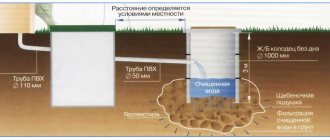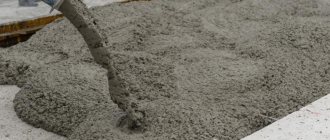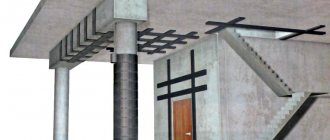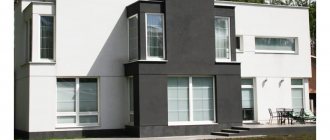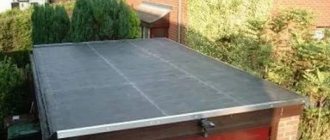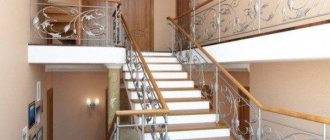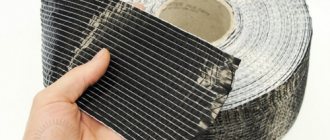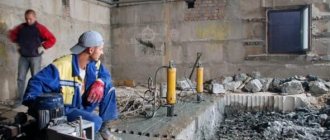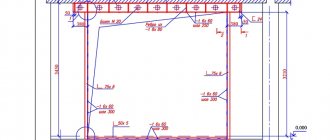- 1 Types of damage to reinforced concrete structures
- 2 Repair methods
- 3 Materials used in repairs
- 4 Conclusion
Modern buildings are made of reinforced concrete slabs, as they are durable, and such structures are stable and durable. Under the influence of unfavorable external factors, destruction can begin much earlier, which leads to consequences that threaten the integrity of the building and even the lives of people nearby. Timely maintenance, detection of the first signs of destruction and their elimination will protect against emergency situations and save money spent on repair work.
At risk of destruction, first of all, are structures where there is constantly high humidity or where chemicals are present. A prerequisite for the destruction of the reinforced concrete structure can be sudden temperature changes and significant load on the tiers of the structure.
Specifics of repair work of concrete products
Any material has its own service life.
The most durable and strong composition may develop cracks over time, and moisture getting inside will accelerate the process of their development. The sooner repair work begins, the more effective it will be. The smallest cracks can gradually turn into a big problem and seriously impair the performance of structures. Often, after settlement, structures become covered with deeper cracks, which can compromise the integrity of the building. Without paying enough attention to the quality of the repair work carried out, the condition of the concrete surface can greatly deteriorate. It not only loses its attractive appearance, but becomes more vulnerable to water penetration, is unable to retain heat and quickly collapses.
Causes and types of damage to be repaired
Almost all concrete products are deformable and can change shape when the operating loads change.
The concrete mixture itself has extremely low tensile strength, which is compensated by the reinforcement of the structure. However, this does not completely solve the problem: cracks still form in the concrete, but they are microscopic in size and much more numerous. Thanks to reinforcement ties, concrete gains durability: small cracks do not affect the strength characteristics in any way, and the limit of permissible crack opening is determined by the technical standards for the product. However, over time, even small cracks expand due to friction and erosion, and it is also possible that the operating conditions of reinforced concrete will change to less favorable ones, which will cause accelerated wear of the structure.
Externally, such phenomena manifest themselves as the opening of wide and deep cracks, as well as in the form of detachment of parts of concrete, up to the exposure of the reinforcement frame. The main reason is water, which saturates the pores and, expanding when freezing, destroys the concrete shell from the inside. If water reaches the reinforcement, the latter intensively corrodes, while the swelling rust prevents the adhesion of concrete to metal and tears the structure from the inside.
There are 5 degrees of damage in total:
- Dirt, pitting and shrinkage cracks.
- Chips, peeling and deterioration of the surface.
- Solid punctures, rust spots, inactive cracks up to 0.2 mm.
- Cracks larger than 0.2 mm, formation of stalactites.
- Breaking off of large pieces with exposed reinforcement, formation of voids and delaminations.
- not affecting the properties of the structure;
- shortening the service life (thinning of the protective layer);
- reducing load-bearing capacity (excluding part of the reinforcement from work due to exposure).
The types of damage are divided into:
In general, we can say that if, due to the exposure of the protective layers of concrete, there is no deformation of the reinforcement frame, the product can be restored relatively easily. The exception is cases of deep corrosion - when, when trying to get to the reinforcement undamaged by rust, it is discovered that the entire frame is affected by it. Then the product is considered unsuitable for use and must be replaced.
Stages of work
- The first step is a thorough examination of the surface of the structures to identify defects. After which a report is drawn up and a technique and material is selected that best satisfies the customer’s requirements.
- The second stage will be preparing the damaged surface for repair. The defective surface of the structure is cleaned of contaminants. The repair area is contoured with a diamond tool. Using a hammer drill, the defective layer of concrete is removed to the entire depth of the damage. The concrete surface is dust-free and moistened.
- The third step is to identify damage to internal fittings. Large cracks expose the internal reinforcement cage. The rods should be cleaned of rust, paint and dust and a protective anti-corrosion coating should be applied to the metal surface.
- Fourth step. Filling the defect with a repair compound. All repair work must be carried out with special compounds and mixtures that do not shrink. The usual combination of sand and cement in this case will not be effective.
Repair compounds for concrete
Before any material is restored, damage is diagnosed. After the analysis, our specialists carefully select the mixture for further reconstruction. Of course, we take special factors into account. These include:
1. Degree of loading of the structure. 2. Level of depth of defects and damage. 3. The state of the environment in which the concrete is located. 4. Difficulty in accessibility of damaged areas.
All this allows us to better study problems to further solve them.
Technology for performing repair work on concrete structures
- The preparation of the repair composition must be carried out in strict accordance with the technical description of the material. Carefully monitor the amount of water added and mixing time.
- Before starting repairs, the concrete structure must be well moistened or coated with a special primer.
- The finished solution is applied with a trowel and its layer should not be more than specified in the instructions. This guarantees the quality of work and durability of the coating. If a large amount of composition is required, the work is carried out in several stages.
Small cracks with a small opening are repaired by jointing (cutting a fine) and sealing with a repair compound. In case of large opening of cracks, the method of structural bonding by injection is used.
For high-quality repair of concrete structures, the ambient temperature should not fall below five degrees and not rise to thirty Celsius.
Failure of concrete structures occurs for various reasons. During manufacturing, the technological process is not followed or low-quality cement is used, corrosion of metal reinforcement or long service life in difficult weather conditions, constant exposure to an aggressive environment or other reasons. The result will be external and internal damage to the structure. Having discovered cracks, you should not postpone repairs, since their width will certainly increase every day, which will ultimately lead to the complete destruction of the object. A major overhaul or complete replacement can be an expensive and complex process.
Causes of defects
The production of structures made of concrete and reinforced concrete is regulated by SP 27.13330.2017 and 63.13330.2012. They contain basic recommendations for the calculation and production of elements, carrying out monolithic or installation work.
If technology is not followed at construction sites, the composition of the concrete mixture is incorrectly selected, loads and operating conditions of structures not taken into account in the calculations, the following arise:
- changes in geometric shapes and sections of structures;
- destruction of coatings;
- material corrosion;
- cracks, chips;
- deformations, deflections;
- failure of adhesion, ruptures, corrosion of reinforcement.
A characteristic sign of destruction is cracks. Determining the reason for their appearance and the degree of opening will allow you to choose the right technique and restore the concrete structure and extend its service life.
The destruction of concrete is accompanied by:
- shrinkage, temperature, technological cracks that appeared before operation as a result of improper manufacturing, transportation, installation of elements or pouring of a monolith;
- operational cracks from temperature influences, improper installation of expansion joints, uneven settlement or soaking of soils, digging pits near foundations, dynamic vibration loads, exceeding the design bearing capacity of superstructures.
Cracks can be longitudinal or transverse, depending on the nature of the damaging load.
Surface defects occur as a result of:
- chemical corrosion, in which the interaction of concrete particles with aggressive substances occurs without the participation of electrolytes and is not accompanied by electric currents;
- electrochemical corrosion in the presence of solutions of salts and alkalis with the occurrence of electric current.
How to choose the right composition
Modern trade organizations offer a huge selection of mixtures suitable for repairing concrete products. If you are not a specialist in this matter, it is best to seek help from a specialist, since in different situations the composition used must have certain properties.
In order to repair vertical or ceiling surfaces, thixotropic compositions are used. If repairs are carried out on a horizontal surface, it is necessary to use a self-leveling composition.
Repairing concrete structures is a complex and responsible process that requires good preparation and many years of practice. Correctly, high-quality work guarantees that the concrete surface will again become strong and reliable and will make it possible to operate the building for many years without fear that it may collapse.
Work process when repairing concrete
Before starting work, the required area is fenced off, equipped with the necessary lighting, tools and the material itself are prepared for the rehabilitation of the concrete surface.
You will receive training from us in the following ways:
1. Mechanical. Here our craftsmen use rotary hammers, hammers, shot blasting machines, sandblasting machines, and picks. 2. Chemical. We use special formulations. The peculiarity of the method is that it is implemented only where it is impossible to use the mechanical method. After completing the procedure, we rinse the surface with water. 3. Hydrojet. Kasr specialists use high-pressure apparatus for this method. This method is applicable in almost any conditions. The only exception is the material’s contraindication to moisture.
Contact the team of specialists from the Moscow company Kasr, and you will find out what high quality and reliability mean. Each team member is responsible for these characteristics to our clients.
Repair of fence posts
Wooden fence posts are susceptible to rotting and drying out. Damaged supports cannot be repaired and must be replaced with new ones. Before installation, it is necessary to treat the material in several layers with anti-rotting impregnation.
Photo No. 6: wooden fences are susceptible to rotting
Metal poles can be exposed to dampness, which will lead to corrosion - rust. Damaged areas of the supports must be cleaned of paint and rust, thoroughly sanded and coated with 1-2 layers of anti-corrosion primer. Then paint again.
Photo No. 7: rust on a metal pole
Remember that a careful approach to choosing a manufacturing company, planning work and installing a fence can save you from having to repair the fence for many years.
How to overhaul the foundation with your own hands?
This chapter will consider an example of replacing brick pillars with a pile-grillage foundation.
It must be noted right away that one person cannot cope with such work on his own. A minimum of 3 people will be required.
The repair process consists of the following stages:
- Preparation.
- Raising the building.
- Installation of a new foundation.
Preparation
Preparation for repair consists of the following:
carry out an inspection of the condition of the foundation structures. As a result, a method for removing old supports is planned.- draw up a project for a new foundation. Based on this, the dimensions of the pillars and grillage are calculated.
- determine the need for concrete mortar, reinforcement, sand, crushed stone and formwork.
- Mark the new foundation.
- select tools (jacks, shovels, wheelbarrow, vibrator, saw, etc.).
Raising a house
To lift a frame-panel residential building, you will need two hydraulic jacks, metal sheets or boards.
Raising the house is carried out as follows:
- The jack is placed on a solid platform made of metal sheet or boards between the pillars.
- A stop made of a metal profile is installed on the lift's patch, the upper end of which is pressed through the lining into the harness (catch) of the building.
- Lifting is carried out until there is a gap between the heads of the pillars and the fence with a height of 200 - 250 mm.
- Wooden pads are inserted into the gaps and the jack rod is lowered. The process is repeated along the entire perimeter of the foundation.
- Jacks are removed from their installation sites.
Installation of a new foundation
The principle of constructing a new foundation is no different from the construction of a conventional pile-grillage foundation.
This happens as follows:
In the designated places, holes are dug to the designed depth.- Sand 100 - 150 mm thick is poured onto the bottom. It is spilled with water and compacted thoroughly.
- Then the pillow is covered with a piece of geotextile, the edges of which are turned up, and secured to the walls of the pit with wood chips or nails.
- Boxes are assembled from boards and timber, the internal perimeter of which corresponds to the transverse size of the new pillars.
- Reinforcement frames are knitted from periodic profile rods ø 8 – 10 mm and smooth reinforcement ø 6 mm. The rods are connected with knitting wire.
- Formwork boxes are lowered into the pits, inside.
- Reinforced frames are placed in the formwork.
- Install the horizontal grillage formwork. To prevent liquid concrete from leaking, the inner surface of wooden panels is covered with PVC film.
- Reinforced frames are knitted in horizontal formwork.
- The vertical outlets of the pillar reinforcement are connected with wire to the horizontal reinforcement of the grillage.
- Check the reliability of fastening the stops and spacers made of timber.
- Order delivery of concrete using an automixer with a feeding console.
- First, the boxes are poured, compacting the solution with a vibrator. Then they begin to fill the grillage formwork with concrete using a vibrator.
- 30 days after concrete work, the formwork panels are dismantled.
- Backfilling is carried out around the new pillars.
- The house is raised with jacks so that it is possible to remove the linings from the heads of the old brick pillars.
- Lifts are used to lower the house onto a new grillage.
- Brick pillars are broken with a jackhammer. The fragments are removed from the plot.
Complete replacement of a columnar brick foundation with a pile-grillage foundation - in the video:
Wooden fence repair
Photo No. 1: repair of a wooden fence
If you notice that the fence around a house on a summer cottage or in the village is leaning, then it’s time to replace the support system for this fence.
Why did the roll occur?
Image #1: Why did the roll occur?
Wooden supports lean when rotted or weakly strengthened. With prolonged contact of wood with moist soil in shaded areas, a natural process of destruction inevitably begins. Healthy but poorly secured supports in holes can also tilt (if the base has not been cemented).
What do we have to do?
It is best to replace a rotten pillar with a new one, and concrete a poorly strengthened one. To do this, the point of insertion of the support is expanded in depth and width by 20–50 cm, then the pillar is leveled/changed, and the base is filled with crushed stone and filled with liquid concrete.
You can prevent a wooden fence from tilting if you pay close attention to the base equipment, and also regularly coat the structural elements with protective compounds against rotting.
ADVICE. Replacing one or more wooden fence posts is best handled by a team of specialists. When purchasing fences for your property, immediately ask the manufacturing company about the possibilities of repairing the structure.
Is it possible to strengthen the supports instead of completely replacing them?
There is an effective technology for strengthening a columnar foundation, which allows you to avoid expensive work on the construction of a new foundation and dismantling of old supports.
The essence of the method is the point introduction of a geopolymer composition under the soles of the supports. The advantage of this reinforcement is the ability to supply the solution to a depth of up to 6 meters and complete immunity to the influence of groundwater.
Strengthening occurs as follows:
A manual hammer drill is used to drill passages in the ground under foundations with a diameter of 32 mm.- Tubes (packers) for injection are inserted into the holes.
- Using special equipment under pressure, an expanding composition (geopolymer resin) is supplied through the packers.
- The resin, expanding, pushes the soil apart and occupies a certain volume.
- The composition hardens in a short time, forming a durable mass.
The advantages of this amplification method include the following:
- when expanding, the polymer resin creates a pressure on the ground of 40 tons/m2;
- within 30 minutes after injection, the resin gains 90% of its strength;
- the service life of the amplification is more than half a century;
- the inertness of the composition does not have a harmful effect on the environment.
You will find a lot of important and useful information about columnar foundations here.
Fence foundation repair
Photo No. 5: fence foundation repair
Mistakes made during the construction of the fence lead to destruction of the foundation. Repair in such situations comes down to several procedures.
- Screed of a deformed or destroyed foundation base. Concrete screed clips are laid on both sides of the support system. Depth - below the broken foundation. The reason is incorrect calculation of the depth when laying the fence.
- Creation of a drainage system. It is carried out when destruction by melt water or underground sources is detected. The reason is the erosion of the foundation.
- Sealing cracks. Produced manually in a step-by-step manner. The reason is the lack of cement in the concrete mixture.
There are many companies engaged in the production and installation of fences in Moscow. However, only a few, like Masterovit, provide guarantees of compliance with GOSTs and provide professional maintenance of their structures.
